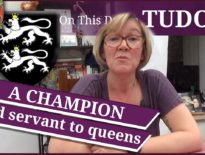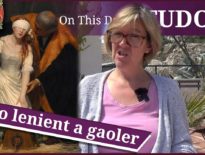On this day in Tudor history, 14th April 1565, in the reign of Queen Elizabeth I, astrologer, astronomer, mathematician and magician, Edward Gresham, was born in Stainsford, Yorkshire.
Gresham is known for his treatise "Astrostereon" and his almanacs, but what's really interesting is his connection to a countess's annulment and a poisoning.
Find out more about Edward Gresham in today's talk.
Also on this day in Tudor history, 14th April 1578, Mary, Queen of Scots' third husband, James Hepburn, Duke of Orkney and 4th Earl of Bothwell, died at Dragsholm Castle in Denmark. He'd been held at the castle in appalling conditions and it was said that he'd gone insane. Find out more about him in last year’s video:
Also on this day in history:
- 1556 – Death of Sir Anthony Kingston, former Constable of the Tower of London, at Cirencester while on his way to be tried in London. He was accused of conspiring to rob the Exchequer for money to support Henry Dudley and his plot against Mary I. Dudley appears to have been planning an invasion of English exiles from France to topple Mary and replace her with Elizabeth.
- 1587 – Death of Edward Manners, 3rd Earl of Rutland, at Greenwich. He'd been taken ill earlier that month. He was buried on 15th May at Bottesford, Leicestershire.
- 1599 – Death of Sir Henry Wallop, member of Parliament and administrator, in Dublin while serving there as Treasurer-at-War. He was buried in St Patrick's Cathedral, Dublin.
Transcript:
On this day in Tudor history, 14th April 1565, in the reign of Queen Elizabeth I, astrologer, astronomer, mathematician and magician, Edward Gresham, was born in Stainsford, Yorkshire.
Gresham is known for his treatise on the planets, “Astrostereon”, and his astrological almanacs, which were published between 1603 and 1607. Gresham’s biographer, Bernard Capp, writes of how his1605 almanac, which sadly no longer exists, apparently foretold the Gunpowder Plot, and in fact was so accurate that Gresham was suspected of being involved in the plot!
Here are some facts about Edward Gresham…
• It is thought that he was educated at Trinity College, Cambridge.
• He had homes in Stainsford, Yorkshire, and in Thames Street, London.
• His 1603 treatise Astrostereon, or a Discourse of the Falling of the Planet, showed that Gresham was in favour of the heliocentric system put forward by Copernicus.
• When accused of being an atheist, Gresham claimed to have written at least two religious treatises, 'Sabbath-dayes exercises' and 'Positions in divinitie', although they were never published.
• As well as being a mathematician, astronomer and astrologer, he also practised medicine and magic, or perhaps witchcraft.
• In 1611, Frances Howard, wife of Robert Devereux, 3rd Earl of Essex, was in need of a magician to help her out of her marriage. Her previous magician, Simon Forman, who had allegedly helped make Robert Carr fall in love with her, had just died, and now she needed someone to step in so that she could get an annulment and marry Carr. Gresham is said to have made her husband impotent and in 1613 the marriage was ruled unconsummated, due to Essex’s impotence, and an annulment was granted. Frances married Carr, who had just become Earl of Somerset, three months after the annulment.
• It was also said that Gresham used his skills as a magician to get rid of courtier Sir Thomas Overbury who was a friend of Robert Carr, but who was opposed to the idea of him marrying Frances and was vocal in his opposition. After refusing a diplomatic posting from King James I, Overbury was imprisoned in the Tower of London and it is there that he died on 15th September 1613. It was rumoured that he was poisoned and that Frances was behind it. It was alleged that the Countess had employed Richard Weston and two others to obtain poison and to put them into food sent to Overbury. Weston was an associate of Gresham, and before his death Gresham gathered together his baubles, things he’d used in his magic, such as pictures in lead and wax and plates of gold of naked people, crosses, crucifixes, and other things, wrapped them in a scarf and gave them to Weston with instructions to bury them so “that no man might find them”. Weston was obviously a man Gresham was close to. However, Gresham died on 13th January 1613, so he cannot be held responsible for Overbury’s death.
• Weston was executed for his involvement in Overbury’s death, and the countess and her husband were imprisoned.
• Gresham was buried on 14th January 1613 at All Saints-the-Less, London. In the Harleian Miscellany, it states that he left behind a man and a maid, “the one hanged for a witch, he other for a thief.”
Also on this day in Tudor history, 14th April 1578, Mary, Queen of Scots' third husband, James Hepburn, Duke of Orkney and 4th Earl of Bothwell, died at Dragsholm Castle in Denmark. He'd been held at the castle in appalling conditions and it was said that he'd gone insane. Find out more about him in last year’s video - https://youtu.be/XRU_nEsUxFw



Leave a Reply